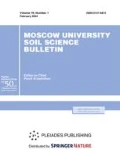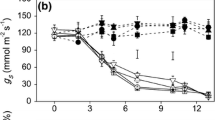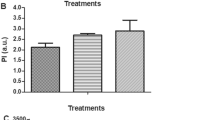Abstract
The efficiency of exogenic 24-epibrassinolide and its products (Epin and Epin-Extra) has been studied. Parallel to an increase in crop productivity (root crops and potatoes in field experiments and barley in vegetation experiment), they exert a favorable effect on the quality of plant production. The vegetation experiment with barley has shown a positive impact of epibrassinolide on the synthesis of protein nitrogen and a rise in its participation in grain. Application of 24-epibrassinolide in the concentration of 10–9–10–7 M at laboratory experiments has resulted in higher activity of nitrate reductase and more intense nitrogen synthesis in juvenile plants of barley. Its effect on processes of nitrogen metabolism and activation of some physiological mechanisms makes higher the quality of agricultural products, which is confirmed with by the content of nitrates, saccharides, starch, and ascorbic acid in reproductive organs of root crops and potatoes at field experiments.
Similar content being viewed by others
References
Allagulova, Ch.R., Gilamov, F.R., Aval'baev, A.M., et al., Structure of the TADHN gene for dehydrin-like protein of soft wheat and activation of its expression by ABA and 24-epibrassinolide, Russ. J. Plant Physiol., 2007, vol. 54, no. 1, pp. 115–120.
Astaf'eva, O.V., Vilkova, D.D., Bataeva, Yu.V., et al., The way to research the antibacterial properties of plants growth-regulator "Epin-Extra" for growing ecologically friendly production, Vestn. Altaisk. Gos. Agrar. Univ., 2015, no. 8 (130).
Budykina, N.P., Shibaeva, T.G., and Titov, A.F., Epin-Extra (synthetic analog of 24-epibrassinolide) effect onto cucumber (Cucumis sativus L.) stress resistance and productivity, Tr. Karel'sk. Nauch. Tsentra, Russ. Akad. Nauk, 2012, no. 2.
Vakulenko, V.V., High crop of healthy tubers obtained with the help of "NEST M" growth-regulators, Kartofel Ovoshchi, 2013, no. 4.
Voronina, L.P. and Mineev, V.G., 24-epibrassinolide effect onto barley growth and development according to mineral feed conditions, Probl. Agrokhim. Ekol., 2009, no. 3.
Zol'nikova, E.V. and Postnikov, A.N., Effect of growth-regulating chemicals onto feeding beet fertility, Zemledelie, 2015, no. 5.
Malevannaya, N.N., Brassinosteroids are the new class of pleiotropic activity phytohormons, in Polifunktsional'nost' deistviya brassinosteroidov. Sb. nauch. tr. (Brassinosteroids Polyfunctional Activity), Moscow, 2007.
Materialy 2-go Vsesoyuznogo soveshchaniya po brassinosteroidam, Tezisy dokladov (11–13 iyunya 1991 g.) (Proc. 2nd All-Union Meeting on Brassinosteroids, June 11–13, 1991, Abstracts of Papers), Akhrem, A.A., et al., Eds., Minsk, 1991.
Postnikov, A.N. and Osetrova, O.B., The way to control potato productivity and crop quality by using growth-regulating chemicals, Dostizh. Nauki Tekhn. Agroprom. Kompl., 2009, no. 8.
Praktikum po agrokhimii (Manual on Agrochemistry), Mineev, V.G., Ed., Moscow, 2001.
Selivanova, M.V., Application efficiency of biologically active matters in table beet growing, Sb. Nauch. Tr. Vseros. Nauch.-Issl. Inst. Ovtsevod. Kozlovod., 2015, vol. 1, no. 8.
Uromova, I.P. and Gribanovskaya, T.V., Brassinosteroids effect onto potato microplants productivity in protected ground, Vestn. Minin. Univ., 2015, no. 2.
Shkodrina, T.A. and Grebneva, Yu.R., Effect of growth-regulating chemicals onto tomatoes fertility and quality, Materialy III nauchno-prakticheskoi konferentsii "Sovremennye aspekty proizvodstva i pererabotki sel'skokhozyaistvennoi produktsii," Krasnodar, 20 marta 2017 g. (Proc. III Sci.-Pract. Conf. "Modern Production and Processing of Agricultural Products," Kransodar, March 20, 2017), Krasnodar, 2017.
Bajguz, A., Effect of brassinosteroids on nucleic acids and protein content in cultured cells of Chlorella vulgaris, Plant Physiol. Biochem., 2000, vol. 38, no. 3. http://www.sciencedirect.com/science/article/pii/ S0981942800007336
Clouse, S.D., Brassinosteroid signal transduction: clarifying the pathway from ligand perception to gene expression, Moll. Cell, 2002, vol. 10, no. 5, pp. 973–982. doi 10.1016/S1097-2765(02)00744-X
Docter, C., Gruszka, D., Brauman, I., et al., Induced variations in brassinosteroid genes define barley height and sturdiness, and expand the green revolution genetic toolkit, Plant Physiol., 2014, vol. 166, no. 4, pp. 1912–1927. doi 10.1104/pp.114.250738
Fariduddin, Q., Khalil, R.R.A.E., Mir, B.A., et al., 24-epibrassinolide regulates photosynthesis, antioxidant enzyme activities and proline content of Cucumis sativus under salt and/or copper stress, Environ. Monit. Assess., 2013, vol. 185, no. 9, pp. 7845–7856. doi 10.1007/s10661-013-3139-x
Grove, M.D., Spencer, G.F., Rohwedder, W.K., et al., Brassinolide, a plant growth-promoting steroid, isolated from Brassica napus pollen, Nature, 1979, vol. 281, pp. 216–217.
Hasan, S.A., Wani, A.S., Irfan, M., and Hayat, S., Brassinosteroids root drenching as an effective method of cadmium induced oxidative stress amelioration in Solanum lycopersicum, Int. J. Chem. Environ. Biol. Sci., 2013, vol. 1, pp. 484–487.
Hayat, S. and Ahmad, A., Soaking seeds of Lens culinaris with 28-homobrassinolide increased nitrate reductase activity and grain yield in the field in India, Ann. Appl. Biol., 2003, vol. 143, pp. 121–124.
Janeczko, A. and Swaczynová, J., Endogenous brassinosteroids in wheat treated with 24-epibrassinolide, J. Biol. Plant, 2010, vol. 54, no. 3. doi 10.1007/s10535-010-0084-1
Khripach, V., Zhabinskii, V., and de Groot, A., Twenty years of brassinosteroids: steroidal plant hormones warrant better crops for the XXI century, Ann. Bot., 2000, vol. 86, pp. 441–447. doi 10.1006/anbo.2000.1227
Kim, G.-T., Fujioka, S., Kozuka, T., et al., CYP90C1 and CYP90D1 are involved in different steps in the brassinosteroid biosynthesis pathway in Arabidopsis thaliana, Plant J., 2005, vol. 41, no. 5, pp. 710–721. doi 10.1111/j.1365-313X.2004.02330.x
Yuan, L., Yuan, Y., Du, J., et al., Effects of 24-epibrassinolide on nitrogen metabolism in cucumber seedlings under Ca(NO3)2 stress, Plant Physiol. Biochem., 2012, vol. 61, pp. 29–35. doi 10.1016/j.plaphy.2012.09.004
Author information
Authors and Affiliations
Corresponding author
About this article
Cite this article
Voronina, L.P., Malevannaya, N.N. The Effect of 24-Epibrassinolide and Its Products on the Content of Total, Protein, and Nitrate Nitrogen in Plants. Moscow Univ. Soil Sci. Bull. 73, 217–222 (2018). https://doi.org/10.3103/S0147687418050083
Received:
Published:
Issue Date:
DOI: https://doi.org/10.3103/S0147687418050083




